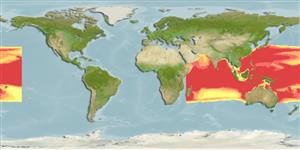>
Stomiiformes (Lightfishes and dragonfishes) >
Stomiidae (Barbeled dragonfishes) > Astronesthinae
Etymology: Astronesthes: Greek, astra = ray + Greek, esthes, -es = suit, something used to wrap (Ref. 45335).
Eponymy: The fallen angel Lucifer, of the Judeo-Christian tradition, is referred to in the fourteenth chapter of the Biblical book of Isaiah: ‘How art thou fallen from heaven, O Lucifer, son of the morning! How art thou cut down to the ground, which didst we [...] (Ref. 128868), visit book page.
More on author: Gilbert.
Environment: milieu / climate zone / depth range / distribution range
Ökologie
seewasser bathypelagisch; tiefenbereich 25 - 704 m (Ref. 58302). Deep-water; 36°N - 33°S, 43°E - 154°W
Indo-Pacific: Japan, off the Hawaiian Islands, and the Timor Sea. Reported from Taiwan (Ref. 5193), Australia (Ref. 7300), and Yemen (Ref. 28061).
Size / Gewicht / Alter
Maturity: Lm ? range ? - ? cm
Max length : 12.0 cm SL Männchen/unbestimmt; (Ref. 41299)
Rückenflossenstacheln (insgesamt) : 0; Rückenflossenweichstrahlen (insgesamt) : 11 - 13; Afterflossenstacheln: 0; Afterflossenweichstrahlen: 17 - 20. AC discontinuous, 2 or 3 photopores ranging from 5th to 8th displaced upward. Barbel distinctly longer than head, its stem speckled with melanophores. A prominent black band extending from ventral to lateral side of caudal peduncle. Attains 12 cm SL.
Found on continental slopes and sea mountains (Ref. 41299). Benthopelagic (Ref. 58302).
Life cycle and mating behavior
Geschlechtsreife | Fortpflanzung | Ablaichen | Eier | Fecundity | Larven
Masuda, H., K. Amaoka, C. Araga, T. Uyeno and T. Yoshino, 1984. The fishes of the Japanese Archipelago. Vol. 1. Tokai University Press, Tokyo, Japan. 437 p. (text). (Ref. 559)
IUCN Rote Liste Status (Ref. 130435: Version 2024-2)
Bedrohung für Menschen
Harmless
Nutzung durch Menschen
Tools
Zusatzinformationen
Download XML
Internet Quellen
Estimates based on models
Preferred temperature (Ref.
123201): 11.7 - 23.4, mean 17.4 °C (based on 430 cells).
Phylogenetic diversity index (Ref.
82804): PD
50 = 0.5000 [Uniqueness, from 0.5 = low to 2.0 = high].
Bayesian length-weight: a=0.00417 (0.00171 - 0.01014), b=3.05 (2.84 - 3.26), in cm total length, based on LWR estimates for this (Sub)family-body shape (Ref.
93245).
Trophic level (Ref.
69278): 3.8 ±0.6 se; based on size and trophs of closest relatives
Widerstandsfähigkeit (Ref.
120179): hoch, Verdopplung der Population dauert weniger als 15 Monate. (Preliminary K or Fecundity.).
Fishing Vulnerability (Ref.
59153): Low vulnerability (10 of 100).
